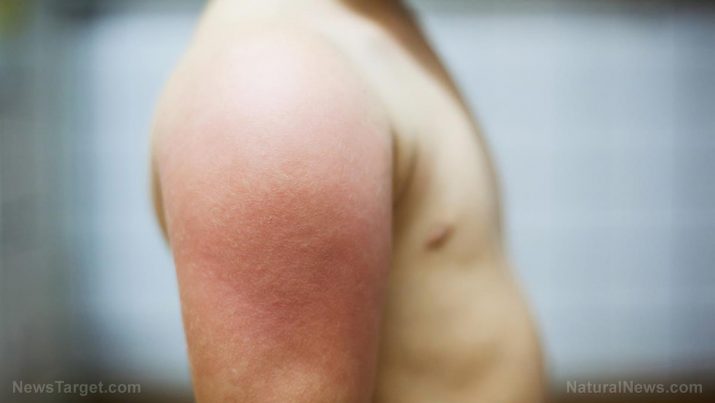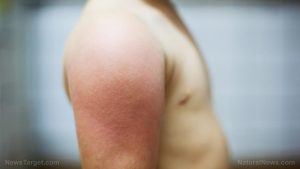
Urticaria – causes, side effects and treatments at NaturalPedia.com
Wednesday, July 11, 2018 by Zoey Sky
http://www.naturalpedia.com/urticaria-causes-side-effects-and-treatments-at-naturalpedia-com.html

Urticaria is a skin condition that occurs when a patient develops a red, raised, itchy rash. It can be triggered by an allergen, an object that causes an allergic reaction.
When an allergic reaction occurs, the body releases histamine and other chemicals. When histamine is released, the capillaries (or tiny blood vessels) emit a fluid. These fluids accumulate under the skin and result in a rash.
At least 20 percent of people will develop urticaria at one point in their life.
The skin condition is not contagious, and urticaria is either acute or chronic.
- Acute urticaria – The most common type of urticaria. Its symptoms last less than six weeks, and they usually manifest in a patient’s face and neck, fingers, toes, and the genitals of males. However, any body part can be affected.
- Chronic urticaria – This type of urticaria continues for over six weeks. Its exact cause remains unknown. Some cases of chronic urticaria can be linked to an underlying autoimmune disorder, like lupus.
Urticaria is also called hives, nettle rash, weals, or welts.

Known side effects of urticaria
The side effects of urticaria usually include:
- An itchy rash – The main side effect of urticaria. The rash may affect any area of skin.
- Weals – These small raised areas look like mild blisters and are also itchy. Weals may be either red or white, and a small red area of skin called a flare often surrounds them. The weals can be about one to two centimeters (cm) across in size, but they can also be bigger or smaller. Patients can have weals in various body parts. In some cases, small weals that are next to each other may join together to form larger weals.
Exposure to the allergens listed below can increase a person’s risk of developing urticaria:
- Bacterial infections (e.g., urinary tract infections [UTI] and strep throat)
- Dust mites
- Extreme temperatures or changes in temperature
- Foods (e.g., nuts, shellfish, strawberries, and wheat products)
- High body temperature
- Infections (e.g., influenza and hepatitis B)
- Medications (e.g., some antibiotics and non-steroidal anti-inflammatory drugs [NSAIDs] like aspirin)
Body systems harmed by urticaria
Urticaria may cause the following complications:
- Anaphylaxis – This refers to a severe allergic reaction that may affect the whole body. It can also cause severe breathing difficulties and a loss of consciousness. When left untreated, anaphylaxis can be fatal. It is considered a medical emergency.
- Angioedema – While similar to urticaria, angioedema affects the deeper layers of the skin. Angioedema may cause potentially serious breathing difficulties.
Food items or nutrients that may prevent urticaria
The following foods or nutrients can help prevent urticaria or address its side effects:
- Aloe vera – Aloe vera has anti-inflammatory and antimicrobial properties that can help minimize inflammation, itching, and redness when applied topically. Taken internally, aloe vera can also stimulate immunity and remove inflammatory toxins.
- Ginger – Ginger can help treat the condition thanks to its potent anti-inflammatory and antihistaminic properties. It is full of phytochemicals like gingerols and shogaols.
- Mint – Mint has a cooling effect and it has many bioactive substances like limonene, menthol, and menthone. It also has anti-inflammatory and antioxidant properties. Additionally, the compounds from mint have antihistaminic and antiallergenic properties.
- Nettle – Nettle is full of bioactive compounds like phenols, vitamins, and minerals. It is a natural antihistamine, and it has anti-inflammatory and astringent properties. Nettle can help relieve inflammation, itching, and swelling.
- Turmeric – Turmeric has anti-inflammatory properties, and it can stimulate the body’s natural anti-inflammatory corticosteroids. It is also an effective natural antihistamine and antioxidant.
Treatments, management plans for urticaria
Urticaria doesn’t usually require any medication since the rash can go away after 24 to 48 hours.
The home remedies listed below can help soothe the itchiness that a patient may feel:
- Calamine lotion or menthol one percent in aqueous cream (don’t leave this on for too long because the itchiness may recur)
- A cool bath or shower
Follow the tips below to avoid triggering urticaria:
- Alcohol, hot baths, intense emotions (anxiety, stress, etc.), and strong sunlight can worsen the side effects of the condition. If these factors cause rashes, do your best to avoid them.
- Avoid wearing tight clothes, especially if weals occur at sites of local pressure (e.g., under belts, etc.).
- Consult a healthcare professional if you believe that your medication is making your symptoms worse.
- Keep cool. A rash may flare up in warmer conditions.
Where to learn more
- EssentialOils.news
- NaturalCures.news
- Naturopathy.news
- Treat chronic hives with vitamin D, says university study
- Vitamin D supplementation helps sufferers of chronic hives
Summary
Urticaria is a skin condition that occurs when a patient develops a red, raised, itchy rash.
The side effects of urticaria usually include an itchy rash and weals.
Urticaria may cause complications like anaphylaxis and angioedema.
Aloe vera, ginger, mint, nettle, and turmeric can help prevent urticaria or address its side effects.
Urticaria doesn’t usually require any treatment since the rash can go away after 24 to 48 hours. Home remedies like calamine lotion or menthol one percent in aqueous cream or a cool bath or shower can help soothe the itchiness that a patient may feel.
Sources include:
Tagged Under: Tags: Urticaria





